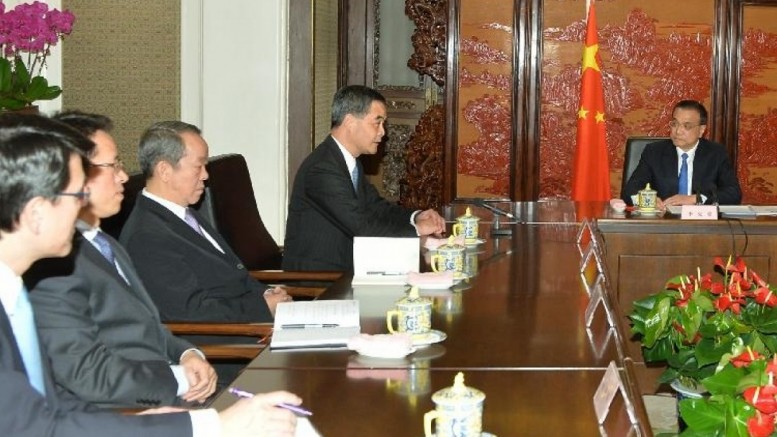By Chris Yeung –
Speaking from his prepared speech at a meeting in Beijing on Wednesday, President Xi Jinping has sought to reassure Hong Kong people and the international community China’s pledge to uphold the Basic Law and the “one country, two systems” policy is “unshakeable” and “will not change.”
In his opening remarks at a session with Chief Executive Leung Chun-ying, he said Beijing would ensure its Hong Kong policy would not be “deformed” when it is put into practice.
Xi admitted he was aware of the controversies surrounding the “one country, two systems” principle in Hong Kong and in the international community in the past year.
He did not elaborate. But last year saw the outbreak of the Occupy Central protests ignited by Beijing’s hardened stance on the issue of universal suffrage in the city. Local people have also fretted about the increasing intervention of mainland authorities in the affairs of the Hong Kong SAR.
Xi’s assurance aside, journalists and political pundits have their eyes set on the marked change in the settings of Leung’s meetings with Xi and Premier Li Keqiang.
In a departure from the customary setting in previous meetings, Xi and Li held meetings with Leung and his aides in a conference room at the Zhongnanhai leadership compound. Both Xi and Li chaired the respective meetings at the head of a long conference table. Officials including Leung sat along the table.
In previous talks in duty visits, Leung and his predecessors sat side by side with state leaders in a setting akin to leaders’ meetings with foreign guests such as government leaders.
Leung ‘marginalised’
Some media reports said Leung was “seated at the margin.”
Both Leung and a spokesman for the Hong Kong and Macau Affairs Office said the new seating arrangement was aimed at better reflecting the relationship between Beijing and Hong Kong as stipulated in the Chinese Constitution and the Basic Law.
Superficially, they have a point. Under the two charters, Hong Kong is a special administrative region of China although it enjoys a high degree of autonomy. Under the Chinese hierarchy, the city’s Chief Executive and the nation’s President are not on equal footing.
Put it in the setting of China Inc, Xi is the board chairman and Leung is the CEO of a subsidiary.
If the pair had been seated side by side in previous meetings, it is because Beijing was anxious to stress the special status of Hong Kong SAR and its CEO to help bolster confidence in the “one country, two systems” policy. The keyword is special.
The profound changes in the mainland-Hong Kong relations in recent years, however, have prompted a rethink by Beijing about the “one country, two systems” principle when it is implemented in the city.
Beijing’s verdict is that they have given too much emphasis on the “special policies” under the notion of “two systems”, but too little on the principle of “one country.”
By changing the seat setting in leaders’ meeting with Leung during the ongoing duty visit, Beijing has given a clear message about who the laoban (boss) is under the Chinese Constitution and the Basic Law.
Gone are the days when the state leaders were eager to give “face” to the SAR chief executive by offering a seat next to them as if they were playing host to foreign visitors.
To Beijing, it is a case of back to normal with the subsidiary’s CEO paying annual visit to report work to his boss in their head office. Nothing special.
Nothing has changed. Really?
Chris Yeung is founder and editor of the Voice of Hong Kong website. He is a veteran journalist formerly worked with the South China Morning Post and the Hong Kong Economic Journal. He writes on Greater China issues.
Photo: Government Information Services picture


Be the first to comment on "One country, two seat settings"